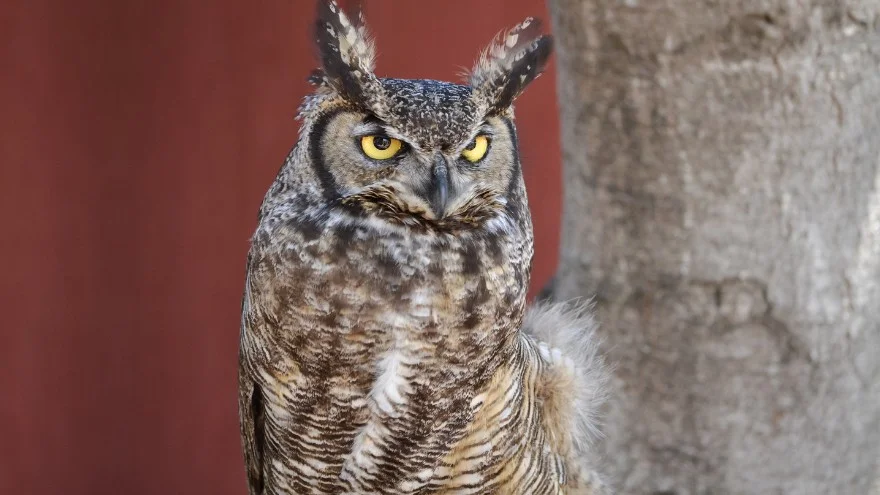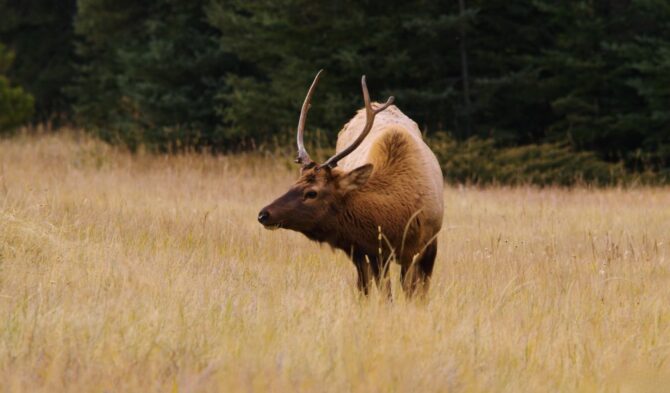Colorado, a state in the west of the United States, is well known for its stunning scenery, wildlife, and vegetation.
The state boasts a diversified topography that includes snow-covered Rocky Mountains, river canyons, and barren deserts, some of which are protected by Rocky Mountain National Park.
The state’s canyons, tundras, and overstory vegetation are home to thirteen owl species prospering.
The Flammulated owl, Barn owl, Great Horned owl, Snowy owl, Eastern screech-owl, Burrowing owl, Long-eared owl, among others, are some of these species of owls in Colorado.
If you want to learn more about these magnificent raptors that resemble a hybrid of cats and birds, continue reading.
Discover the Species of Owls in Colorado
Below are the twelve types of owls that can be found in the state of Colorado, their peculiarities, and how to identify them.
1. Flammulated Owl
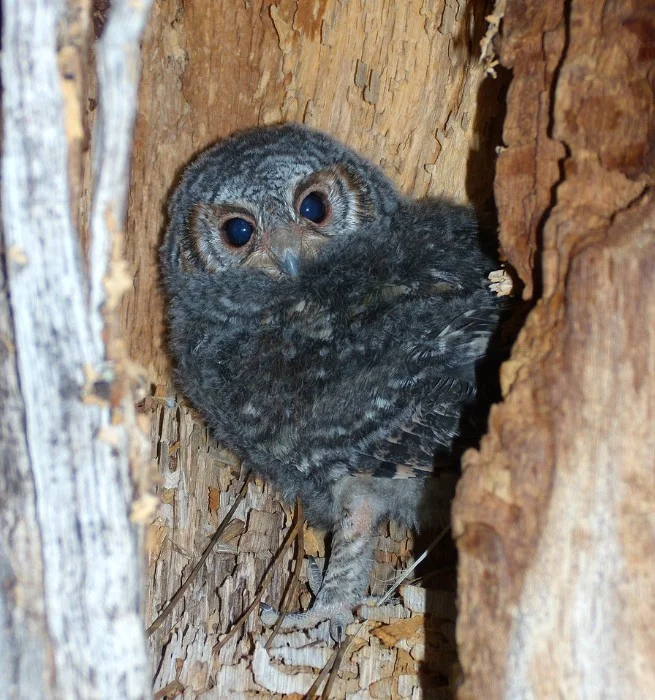
- Scientific Name: Psiloscops flammeolus
- Length: 5.9 – 6.7 inches (15 – 17 cm)
- Weight: 43 – 63 g (0.09 – 0.14 lbs)
- Wingspan: 15.9 – 16.1 inches (40.5 – 41 cm)
Flammulated owls are the tiniest owls in Colorado. These nocturnal, monogamous, grey, or rust-colored birds spend the warm summer and spring months in Colorado before migrating to Central America and Mexico for the winter.
They can be found in the habitats of deep coniferous forests, which offer natural concealment and nesting.
As a result of deforestation, which eliminates their native habitats for breeding and nesting, flammulated owls are gradually going extinct.
Small owls typically produce a wide variety of calls, such as twitters, mews, peeps, hisses, snores, moans, and screams.
2. Barn Owl
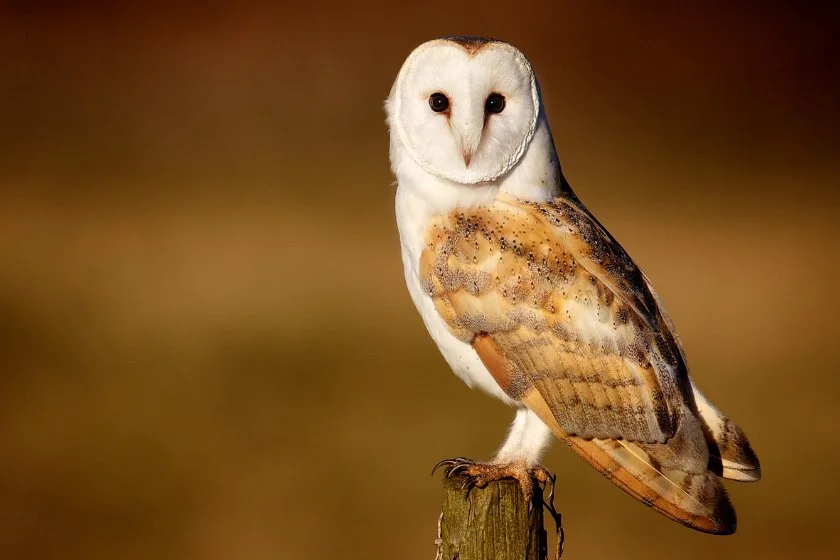
- Scientific Name: Tyto alba
- Length: 12.6 – 15.8 inches (32 – 40 cm)
- Weight: 400 – 700 g (0.9 – 1.5 lbs)
- Wingspan: 99.1 – 114.3 cm ( 39 – 45 inches)
Despite not being domesticated, Barn owls live in barns, which is how they got their name.
Barn owls of the Tytonidae family are lifelong residents of Colorado. Except for barn owls, all owls are members of the Strigidae family due to their distinct but mesmerizing facial features.
The distinguishing features of this owl family include a downward-facing beak and an almost spherical shape that resembles the heart symbol.
Barn owls are powerful predators by sound alone because of their characteristically pale faces with darker borders and a face that dips towards the ears.
The face has buff and grey feathers, but it often seems completely white at night.
Barn owls are monogamous. They spend their nights hunting in grasslands and have a lifespan of about four years.
Instead of hooting as other owls do, they utter a 2 second lengthy, terrible scream.
The male is the main maker and frequently calls repeatedly from the air. Rarely do females make the call. A purring call is a softer variation of this.1
3. Western Screech Owl
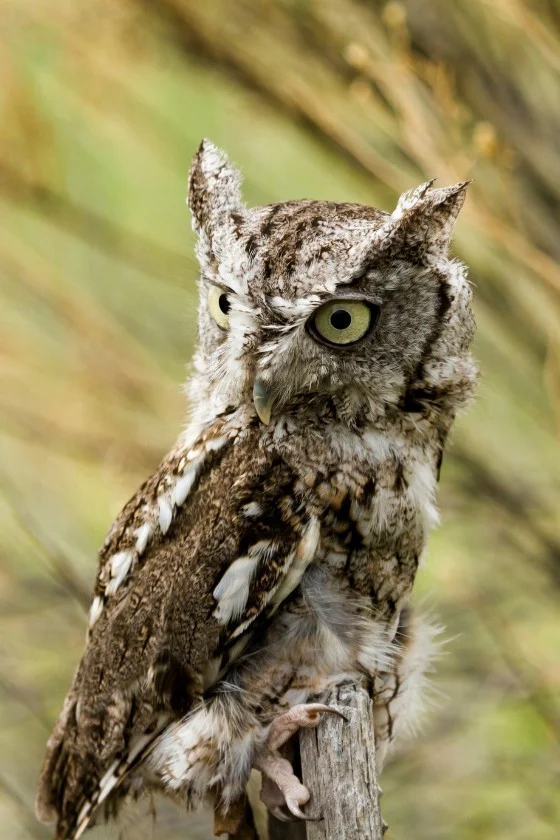
- Scientific Name: Megascops kennicottii
- Length: 7.5 – 9.8 inches (19 – 25 cm)
- Weight: 100 – 305 g (0.22 – 0.67 lbs)
- Wingspan: 21.6 – 24.4 in (55 – 62 cm)
Western screech owls are distinguished by their loud, high-pitched screeches. They sound different from eastern screech owls and have lighter belly and chest patterns.
They are also challenging to spot because of their excellent camouflage and ability to blend in with their surroundings.
These owls usually build their nests near canyon rims. But there have been reports of sightings close to urban centers.
This owl is a year-round inhabitant of Colorado. During mating season, this raptor, which is polygamous, will mate with a number of females.
It’s interesting to note that the male would keep the female of his choosing so they could rear a brood together.
They can be found in parks, cities, and open woodlands in parts of southern and southeastern Colorado.
Western screech owls produce a “toot toot” sound rather than the screeching sound of their eastern screech owl cousin.
4. Great Horned Owl
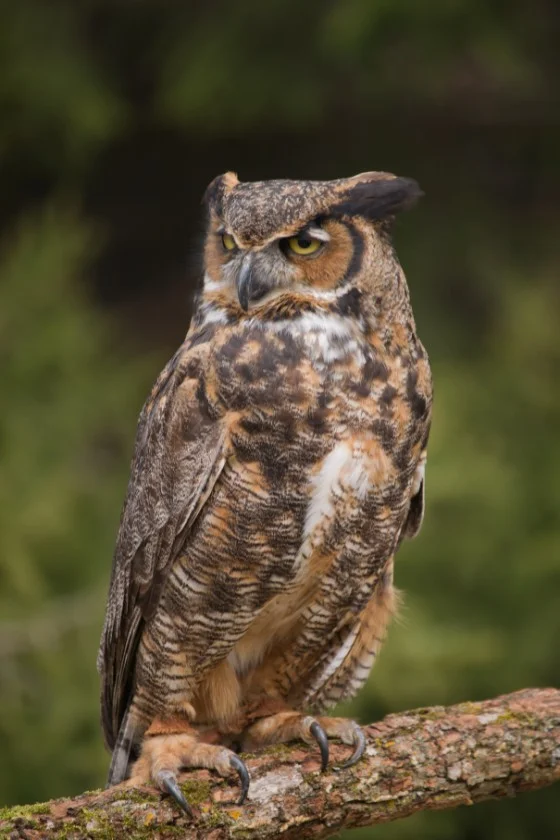
- Scientific Name: Bubo virginianus
- Length: 18.1 – 24.8 inches (46 – 63 cm)
- Weight: 910 – 2500 g (2.0 – 5.5 lbs)
- Wingspan: 39.8 – 57.1 inches (101 – 145 cm)
The Great horned owl is the largest and most prevalent owl species in Colorado.
Only a few may be seen in Colorado because of their great size, even though they can live everywhere, including in man-made structures.
Its distinctive plumicorn head characteristics, which resemble ears, account for its popularity.
Great horned owls are fearsome predators thanks to their distinctive feather plumes that promote stealth and remarkable eyesight 100 times greater than humans.
They have been observed in every state park in Colorado, making them year-round state inhabitants.
Great horned owls do not have horns despite their name. Instead, what appears to be horns are plumicorns, tufts of feathers.
They can see in the dark 100 times better than humans and have incredible hearing and vision.
They can fly softly and approach their prey covertly because of unique wing feathers filaments.
5. Snowy Owl
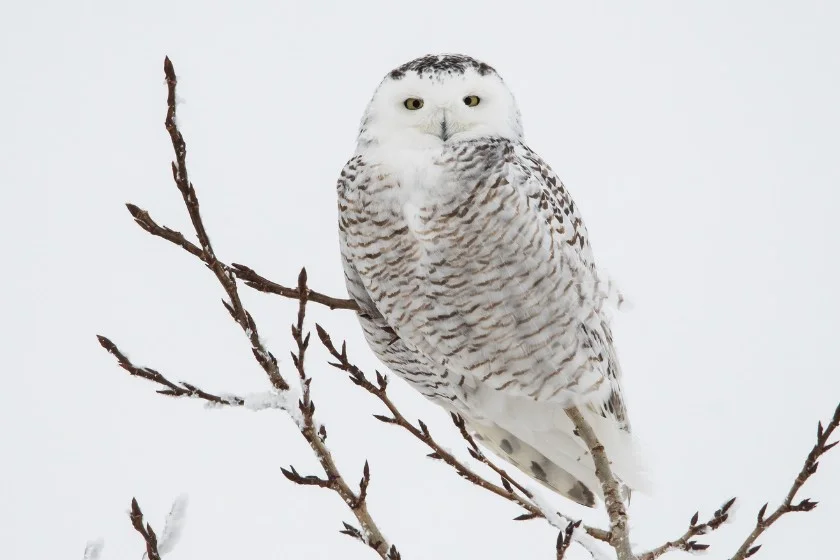
- Scientific Name: Bubo scandiacus
- Length: 20.5 – 27.9 inches (52 – 71 cm)
- Weight: 1600 – 2950 g (3.5 – 6.5 lbs)
- Wingspan: 49.6 – 57.1 in (126 – 145 cm)
The fact that snowy owls can only be seen in Colorado makes them special. Usually, these raptors travel to the tundra in northern Canada, where they spend the entire winter mating and reproducing.
When the weather turns chilly, and the first light snowflakes start to fall, they drift south and even reach the northern United States.
They migrate in such vast numbers that their population in the south occasionally increases dramatically.
Males hoot to defend their territory, and the sound can travel seven miles in the tundra.
Females hardly ever hoot, but both sexes make other noises by cackling, hissing, shrieking, and snapping their beaks.
Snowy owls are among the most striking birds seen in Colorado, thanks to their white plumage.
Normally, they reside in Canada, Alaska, and the Arctic Tundra; they only infrequently travel to Colorado and neighboring states like Oklahoma if their usual habitat is starved of food.
Males make low, strong, slightly rasping hoots, but both sexes do as well. They are frequently given in pairs, although they can also come in groups of up to six.
6. Eastern Screech Owl

- Scientific Name: Megascops asio
- Length: 6.3 – 9.8 inches (16 – 25 cm)
- Weight: 121 – 244 g (0.27 – 0.54 lbs)
- Wingspan: 18.9 – 24.0 inches (48 – 61 cm)
Eastern North America is home to the eastern screech owl, a diminutive owl that resembles a robin in size.
This species is native to most of the wooded areas in its territory, and more than any other owl in its range, it has adapted well to human development. Yet, its exclusively nocturnal activities usually help it avoid notice.
Only in the easternmost regions of the state, close to the border, is the eastern screech owl, a year-round resident of Colorado.
They can be discovered in farm groves, woodlands, and shade trees. An eastern screech owl has excellent camouflage and can blend in with the trees it nests.
Despite their name, these owls do not screech; instead, they make mild trills and whinnies as their sound.
They are renowned for creating various noises, including songs, hoots, rattles, and bill snaps. While it is possible to hear these owls calling during the day, it is best to do so at night.
7. Burrowing Owl
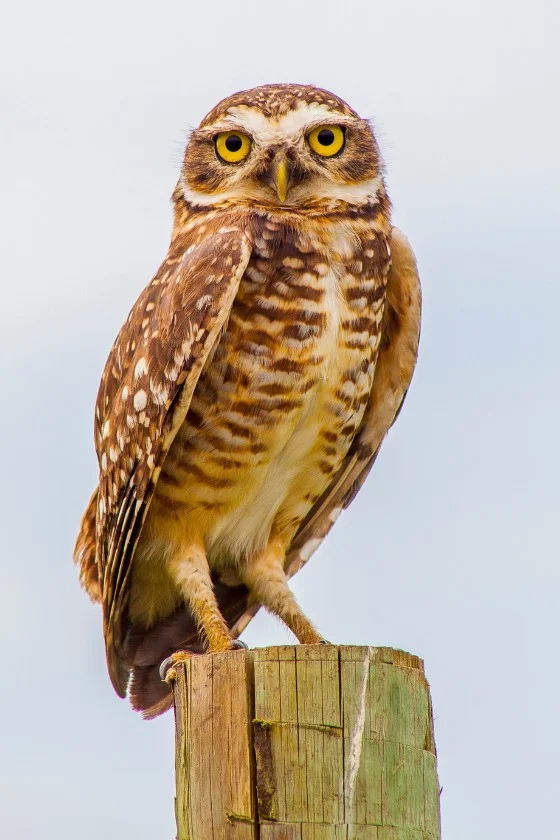
- Scientific Name: Athene cunicularia
- Length: 7 – 10 inches (17.8 – 25.4 cm)
- Weight: 140 – 240 g (0.3 – 0.5 lbs)
- Wingspan: 20 – 24 inches (50.8 – 61 cm)
Sand-colored Burrowing owls have long legs and golden eyes. They are the only owls, like moles, that dwell underground.
They remain in the Colorado prairie dog villages despite being legally listed as a threatened species because those settlements are dying quickly.
Most other owl species are nocturnal, making these owls one of the few that are diurnal (active during the day).
Burrowing owls are a ground-dwelling species, so you won’t see them in trees; they are most prevalent on the Eastern plains.
Burrowing owls breed in Colorado, but they migrate to Mexico and the southwestern United States during the winter.
The burrowing owl is not particularly vocal, yet it can make a range of cooing, chirping, rasping, clucking, shrieking, and rattling sounds.
Males frequently make a two-note cooing sound similar to a quail during mating and territorial defense. They can also imitate the rattlesnake’s warning sound to frighten off predators.
8. Long-Eared Owl

- Scientific Name: Asio otus
- Length: 13.8 – 15.8 inches (35 – 40 cm)
- Weight: 220 – 435 g (0.5 – 0.96 lbs)
- Wingspan: 35.4 – 39.4 inches (90 – 100 cm)
The Long-eared owl is a medium-sized species with a wide breeding range.
It is also referred to as the northern long-eared owl or, more colloquially, as the lesser horned owl or cat owl.
Although their bodies are smaller, they resemble great horned owls in that they have ear tufts.
They may also exhibit what appears to be an astonishing expression due to their wide faces and huge eyes.
The activity of long-eared owls is primarily nocturnal. The species typically start moving around at dusk.
Although they prefer to roost and nest in dense stands of wood, they prefer semi-open habitats, particularly woodland edges, and hunt over open terrain.
The easiest method to find long-eared owls in Colorado is by listening for their mating-season sounds when the males make a low “hoo” sound that may be heard from half a mile away.
9. Mexican Spotted Owl
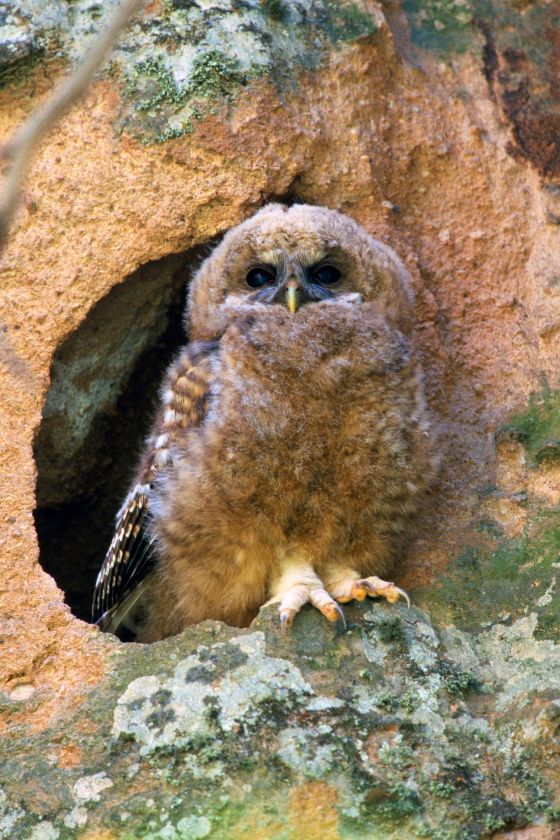
- Scientific Name: Strix occidentalis lucida
- Length: 18.5 – 18.9 inches (47 – 48 cm)
- Weight: 500 – 700 g (1.1 – 1.5 lbs)
- Wingspan: 39.8 inches (101 cm)
The Spotted owl has three subspecies. One of them, the Mexican Spotted Owl, resides in Colorado year-round.
They feature distinctive, recognizable white patterns on their tails, breasts, and backs. Their striking facial discs can also recognize them.
These spotted owls like to nest on the borders of deep, narrow canyons, likely to protect their nests, and their natural habitat is dense hardwood forests.
Owls are fairly intelligent according to their capacity to conceal extra food and later recall the exact position.
The owl’s signal call is a series of four hooted notes, with the middle two being the closest together.
Adult males and females use it to mark and defend territory and deliver food to females. Female vocals are higher than male voices in the hoots, which have a deep, clean tone.
10. Short-Eared Owl
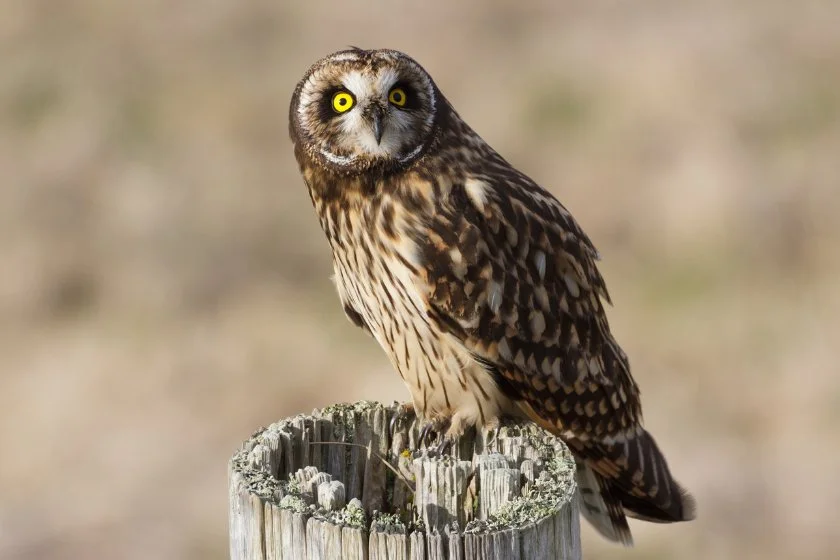
- Scientific Name: Asio flammeus
- Length: 13.4 – 16.9 inches (34 – 43 cm)
- Weight: 206 – 475 g (0.45 – 1.05 lbs)
- Wingspan: 33.5 – 40.5 inches (85 – 103 cm)
One of the rare owls seen during the day is this small, medium-sized bird with a light brownish or orange-brownish color.
In Colorado, meadows, fields, grasslands, and even airports are good places to look for Short-eared owls in the late evenings or early morning.
Short-eared owls can be identified by their ringed faces and lack of ear tufts.
They are most active at dawn and dusk and can be found all over Colorado in the winter, but they migrate to Canada and the northern United States to breed in the warmer months.
The short-eared owl does not have a loud voice. Males make their main call, a dozen or more hoots in succession, both in flight, on the ground, or from an elevated perch during courtship.
When defending the nest, young males and females can bark, scream, or whine. Sometime females will cluck like a bird.
11. Northern Saw-Whet Owl
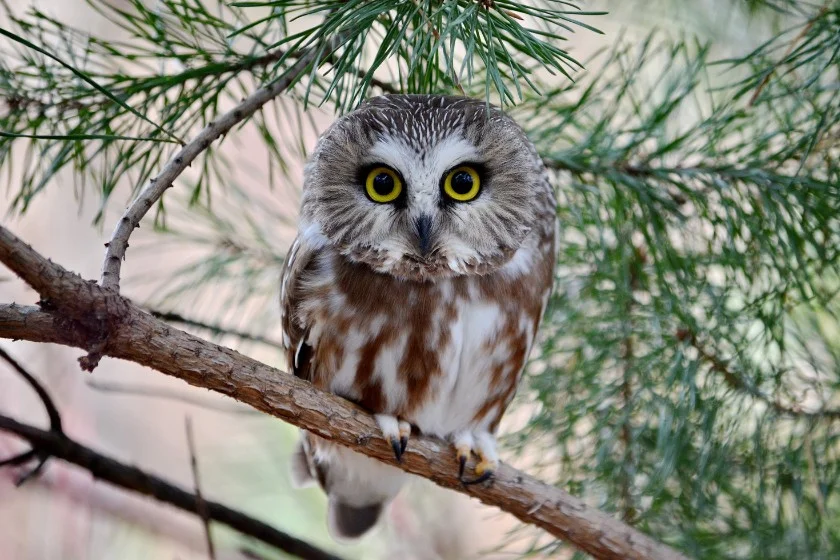
- Scientific Name: Aegolius acadicus
- Length: 7.1 – 8.3 inches (18 – 21 cm)
- Weight: 65 – 151 g (0.14 – 0.33 lbs)
- Wingspan: 16.5 – 18.9 inches (42 – 48 cm)
The small and short-bodied Northern saw-whet owl lives permanently in Colorado. It resides in the Colorado mountains.
Although they have been seen nesting in man-built boxes, northern saw-whet owls typically build their nests in old woodpecker holes excavated in deciduous trees.
The name “saw-whet” for these owls, which have reddish-brown feathers and yellow eyes, is derived from their call, which sounds like a sharpened saw. When it’s time for mating, they make a completely different sound.
The females are polygamous throughout the mating season and will mate with a number of males before moving on to find a new spouse as soon as the current brood develops feathers.
12. Northern Pygmy Owl
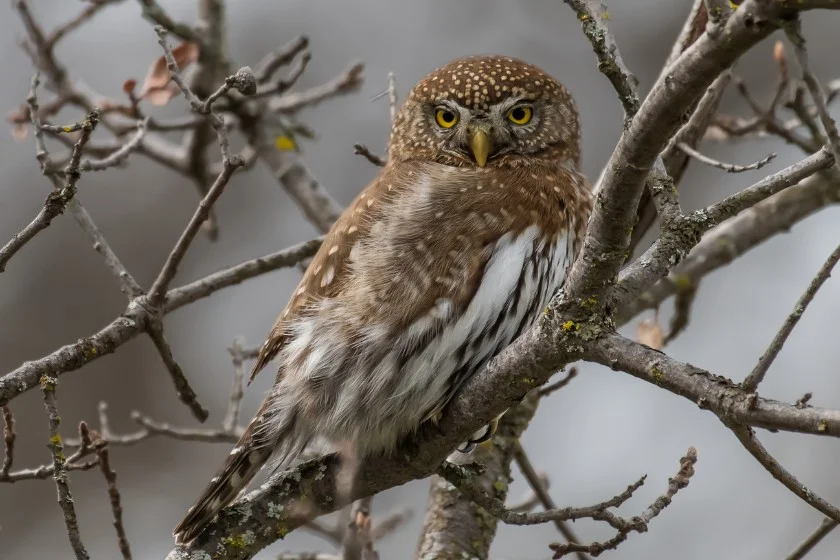
- Scientific Name: Glaucidium californicum
- Length: 7 – 7.5 inches (17.8 – 19.1 cm)
- Weight: Male: 62.4g (0.14 lbs); Female: 73.7g (0.16 lbs)
- Wingspan: 14.5 – 16 inches (36.8 – 40.6 cm)
Another extremely little species of owl is the Northern pygmy. One of their distinguishing characteristics is the two dark eye spots on the back of their heads.
Other distinguishable characteristics include their diminutive stature, yellow beaks and eyes, and white head speckles. They are quite elusive due to their size and coloring.
Because they are diurnal or active during the day, northern pygmy owls have a good chance of being seen in Colorado.
They are found in Colorado’s foothills and mountains, making their homes in old woodpecker burrows.
The rapid, high-pitched, brief trill of this owl’s call frequently comes before the song. The males’ call has a recognizable rhythm.
13. Boreal Owl
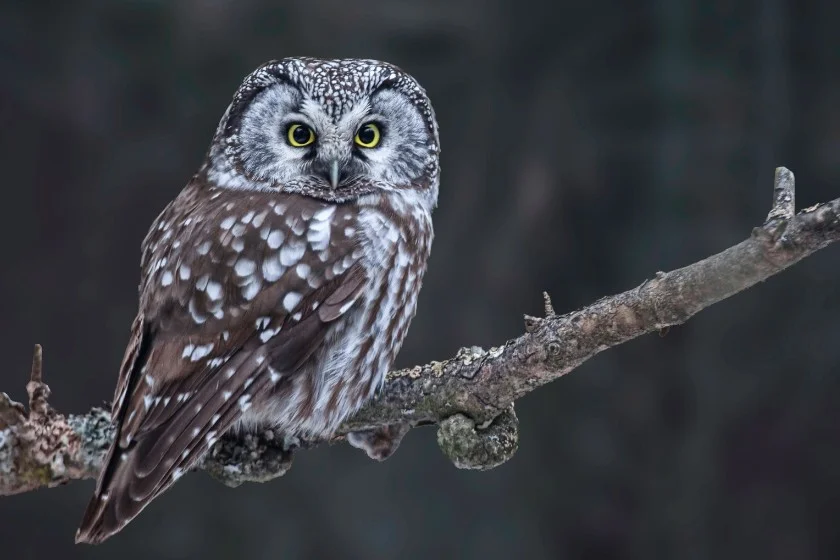
- Scientific Name: Aegolius funereus
- Length: 8.3 – 11.0 inches (21 – 28 cm)
- Weight: 93 – 215 g (0.2 – 0.5 lbs)
- Wingspan: 21.6-24.4 inches (55 – 62 cm)
Small owls with squarish features and vivid yellow eyes are known as Boreal owls. Its most distinctive characteristic is the projecting cluster of feathers on this owl’s normally flat head, which gives it a crew-cut appearance.
Boreal owls are so named because they inhabit boreal woodlands. Only around seven states in the United States are home to the boreal owl, and Colorado is one of them.
These owls are year-round residents of much of central and northern Colorado. They adore living at high altitudes in northern Colorado, perhaps for protection and better food availability.
Normally silent and nocturnal, this northern owl only makes noise during the breeding season to lure a potential partner.
They only appear at night; the optimum viewing window is from mid-February through April.
The males make a succession of 8–20 low, progressively louder whistles. They sing until they locate a partner or the female begins to build a nest. The song frequency drops to almost complete silence at this time.
What are some bird-watching spots in Colorado?
Given that it lacks an ocean coastline, Colorado’s ranking among the top ten states with the largest bird lists is astounding.
Colorado is still able to qualify since it has a lot of land and a variety of habitats.
Here are some of the birding hotspots in Colorado:
- Colorado National Monument.2
- Rocky Mountain National Park.
- Barr Lake State Park.
- John Martin Reservoir State Park.
- Chico Basin Ranch.
Frequently Asked Questions
What is the most common owl in Colorado?
The great horned owl is the largest and most prevalent owl species in Colorado.
What time of the year would you see owls?
The best time to go owling can be from mid-summer to the beginning of autumn, but when young owls first spread their wings, they might be less elusive and simpler to spot.
Wrap-up
It can be fascinating to see owls, and Colorado is home to a few species that you can see in their natural environment.
We hope you’ve been able to learn more about this bird’s habits, habitats, how long it stays in a state (its migrating behaviors), and how to locate a certain species.
Next Up…
- Owl Legs: Fascinating Facts You May Not Know (With Pictures)
- 15 Biggest Birds In The World (Largest Species + Pictures)
- 15 Most Dangerous Animals In The United States
References & Notes
- Elnador. 2014. The Singing Behavior of the Barn Owl (Tyto alba). The Gall Lab, Vassar College.
- Colorado National Monument. U.S. Department of the Interior.
